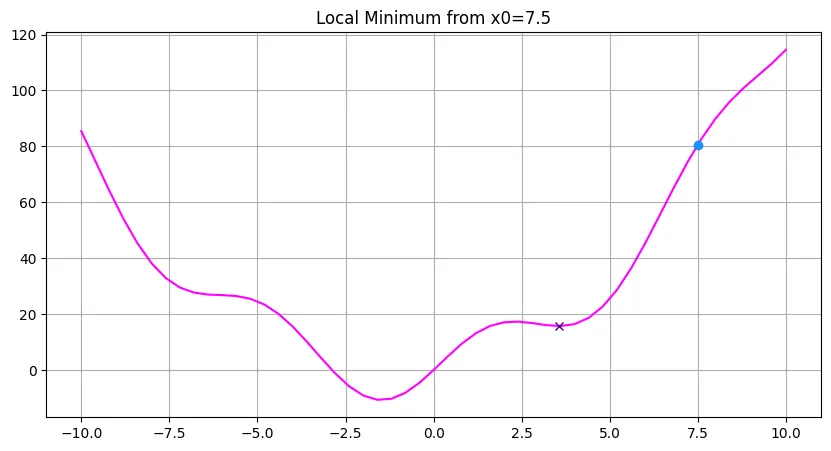
SciPy Introduction
import matplotlib.pyplot as plt
import numpy as np
import scipy.optimize as opt
Global Minimum and Maximum
def f(x):
return x**2 + 10*np.sin(x) + 2*x
x = np.linspace(-10,10,51)
y = f(x)
fig = plt.figure(figsize=(10,5))
plt.plot(x,y)
plt.title('f(x)=x² + 10*sin(x) + 2*x')
plt.grid()
fig.savefig('assets/SciPy_Introduction_00.webp', bbox_inches='tight')

BFGS (Broyden-Fletcher-Goldfarb-Shanno Algorithm)
# start searching for a local minimum at x0=0
x0 = 0
# use BFGS (Broyden-Fletcher-Goldfarb-Shanno Algorithm)
[xopt, fopt, gopt, Bodpt, func_calls, grad_calls, warnflags] = opt.fmin_bfgs(
f, x0=x0,
maxiter=2000,
full_output=True
)
Optimization terminated successfully.
Current function value: -10.728527
Iterations: 5
Function evaluations: 12
Gradient evaluations: 6
fig = plt.figure(figsize=(10,5))
plt.plot(x,y, c='fuchsia')
# start point f(x) = -10.728527
plt.plot([x0], [f(x0)], 'o', c='dodgerblue')
# found minimum @[xopt, fopt]
plt.plot([xopt], [fopt], 'x', c='indigo')
plt.title('Global Minimum from x0=0')
plt.grid()
fig.savefig('assets/SciPy_Introduction_01.webp', bbox_inches='tight')

# start searching for a local minimum at x0=7.5
x0 = 7.5
# use BFGS (Broyden-Fletcher-Goldfarb-Shanno Algorithm)
[xopt, fopt, gopt, Bodpt, func_calls, grad_calls, warnflags] = opt.fmin_bfgs(
f, x0=x0,
maxiter=2000,
full_output=True
)
fig = plt.figure(figsize=(10,5))
plt.plot(x,y, c='fuchsia')
# start point [x0, f(x0)]
plt.plot([x0], [f(x0)], 'o', c='dodgerblue')
# found minimum @[xopt, fopt]
plt.plot([xopt], [fopt], 'x', c='indigo')
plt.title('Local Minimum from x0=7.5')
plt.grid()
fig.savefig('assets/SciPy_Introduction_02.webp', bbox_inches='tight')
The algorithm stops searching for a global minimum after finding the first local minimum:
Optimization terminated successfully.
Current function value: 15.730518
Iterations: 5
Function evaluations: 22
Gradient evaluations: 11

Basin-Hopping Algorithm
# start searching for a local minimum at x0=7.5
x0 = 7.5
# the bh algo requiers a max number of jumps it should perform niter
# and a temperature parameter T that allows for larger jumps to be able
# to hop over local minimums with a maximum step size of stepsize
results = opt.basinhopping(f, x0 = x0, niter=3, T=1, stepsize=2)
results
fun: -10.728527164657866
lowest_optimization_result: fun: -10.728527164657866
hess_inv: array([[0.08364616]])
jac: array([-2.38418579e-07])
message: 'Optimization terminated successfully.'
nfev: 10
nit: 3
njev: 5
status: 0
success: True
x: array([-1.47554364])
message: ['requested number of basinhopping iterations completed successfully']
minimization_failures: 0
nfev: 64
nit: 3
njev: 32
success: True
x: array([-1.47554364])
fig = plt.figure(figsize=(10,5))
plt.plot(x,y, c='fuchsia')
# start point [x0, f(x0)]
plt.plot([x0], [f(x0)], 'o', c='dodgerblue')
# found minimum @[xopt, fopt]
plt.plot([results.x], [results.fun], 'x', c='indigo')
plt.title('Local Minimum from x0=7.5')
plt.grid()
fig.savefig('assets/SciPy_Introduction_03.webp', bbox_inches='tight')

# start searching for a local minimum at x0=7.5
x0 = 7.5
# increase temperature and max allowed stepsize to 3
results = opt.basinhopping(f, x0 = x0, niter=3, T=2, stepsize=3)
fig = plt.figure(figsize=(10,5))
plt.plot(x,y, c='fuchsia')
# start point [x0, f(x0)]
plt.plot([x0], [f(x0)], 'o', c='dodgerblue')
# found minimum @[xopt, fopt]
plt.plot([results.x], [results.fun], 'x', c='indigo')
plt.title('Global Minimum from x0=7.5')
plt.grid()
fig.savefig('assets/SciPy_Introduction_04.webp', bbox_inches='tight')

Curve Fitting
# generate noisy data based on function above
y_noisy = f(x) + 7*np.random.randn(x.size)
fig = plt.figure(figsize=(10,5))
plt.plot(x,y_noisy, 'o', c='dodgerblue', markersize=1.5, label='noisy data')
plt.plot(x,y, c='mediumseagreen', linewidth=0.2, label='ground truth')
plt.title('f(x)=x² + 10*sin(x) + 2*x (Noisy)')
plt.legend()
plt.grid()
fig.savefig('assets/SciPy_Introduction_05.webp', bbox_inches='tight')

# find optimum for variables in f(x)=ax² + b*sin(x) + c*x
# to find a best fit to noisy data
def f_guess(x, a, b, c):
return a*x**2 + b*np.sin(x) + c*x
# start guessing with a to c = 2
start_values = [2,2,2]
params, cov = opt.curve_fit(f_guess, x, y_noisy, start_values)
params
array([ 0.97651997, 10.38400783, 2.06441947])
def f_fitted(x, a_fit, b_fit, c_fit):
return a_fit * x**2 + b_fit * np.sin(x) + c_fit * x
y_fitted=f_fitted(
x,
a_fit=params[0],
b_fit=params[1],
c_fit=params[2]
)
fig = plt.figure(figsize=(10,5))
plt.plot(x,y_noisy, 'o', c='dodgerblue', markersize=1.5, label='noisy data')
plt.plot(x,y_fitted, c='fuchsia', linewidth=1.5, label='fitted function')
plt.title('f(x)=a*x² + b*sin(x) + c*x (Fitted)')
plt.legend()
plt.grid()
fig.savefig('assets/SciPy_Introduction_06.webp', bbox_inches='tight')
